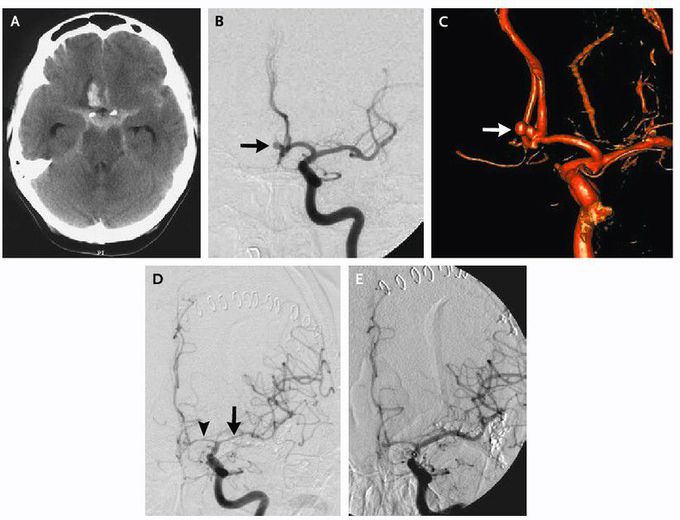


Aneurysmal Subarachnoid Hemorrhage
Subarachnoid Hemorrhage in a 69-Year-Old Woman. This patient, who had a long-standing history of smoking and hypertension, presented to the emergency room with severe headache with nausea and vomiting for four hours and had meningismus on physical examination. Initial computed tomography (CT) of the head revealed a subarachnoid hemorrhage, a right frontal hematoma suggestive of an anterior communicating artery aneurysm, and hydrocephalus (Panel A). An external ventricular drain was inserted on arrival. Digital-subtraction cerebral angiography (oblique view) showed an aneurysm stemming from the anterior communicating artery (Panel B, arrow). Three-dimensional digital-subtraction angiography clearly showed the bilobed, irregular nature of the aneurysm (Panel C, arrow). The patient underwent craniotomy and sur- gical clipping of the aneurysm, with good postoperative recovery. Six days after admission, the patient had rapid onset of global aphasia and right hemiparesis. Transcranial Doppler ultrasonography demonstrated a severe eleva- tion in blood-flow velocities (>200 cm per second) in the left middle and anterior cerebral arteries. Angiography showed considerable vasospasm (Panel D) in the proximal segments of the left anterior arteries (arrowhead) and middle cerebral arteries (arrow). The patient underwent transluminal balloon angioplasty of the left middle cerebral artery, and direct vasodilators (papaverine and verapamil) were infused into the left anterior cerebral artery with good resolution of the vasospasm (Panel E). The patient’s clinical course evolved favorably, and she was indepen- dent three months after presentation

